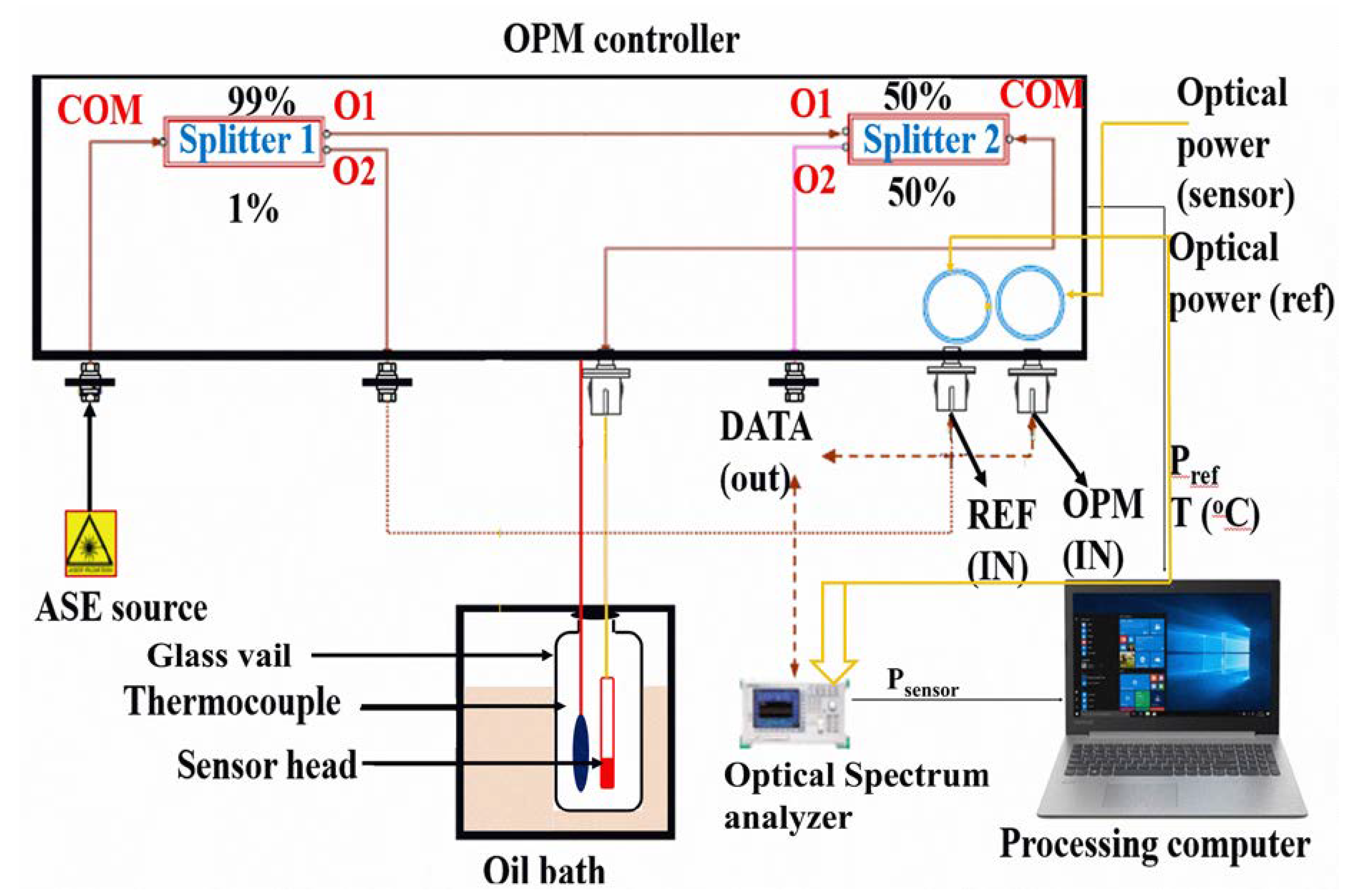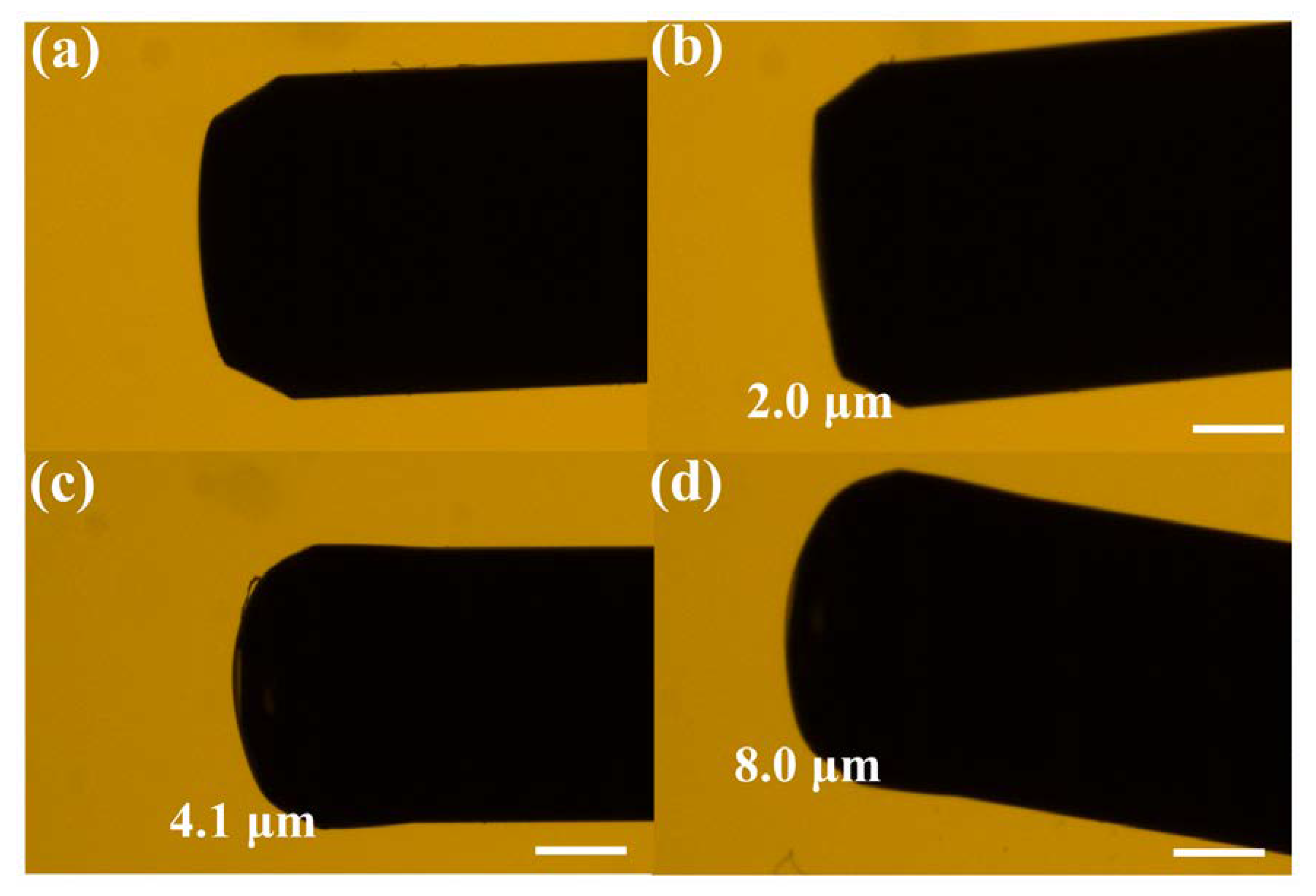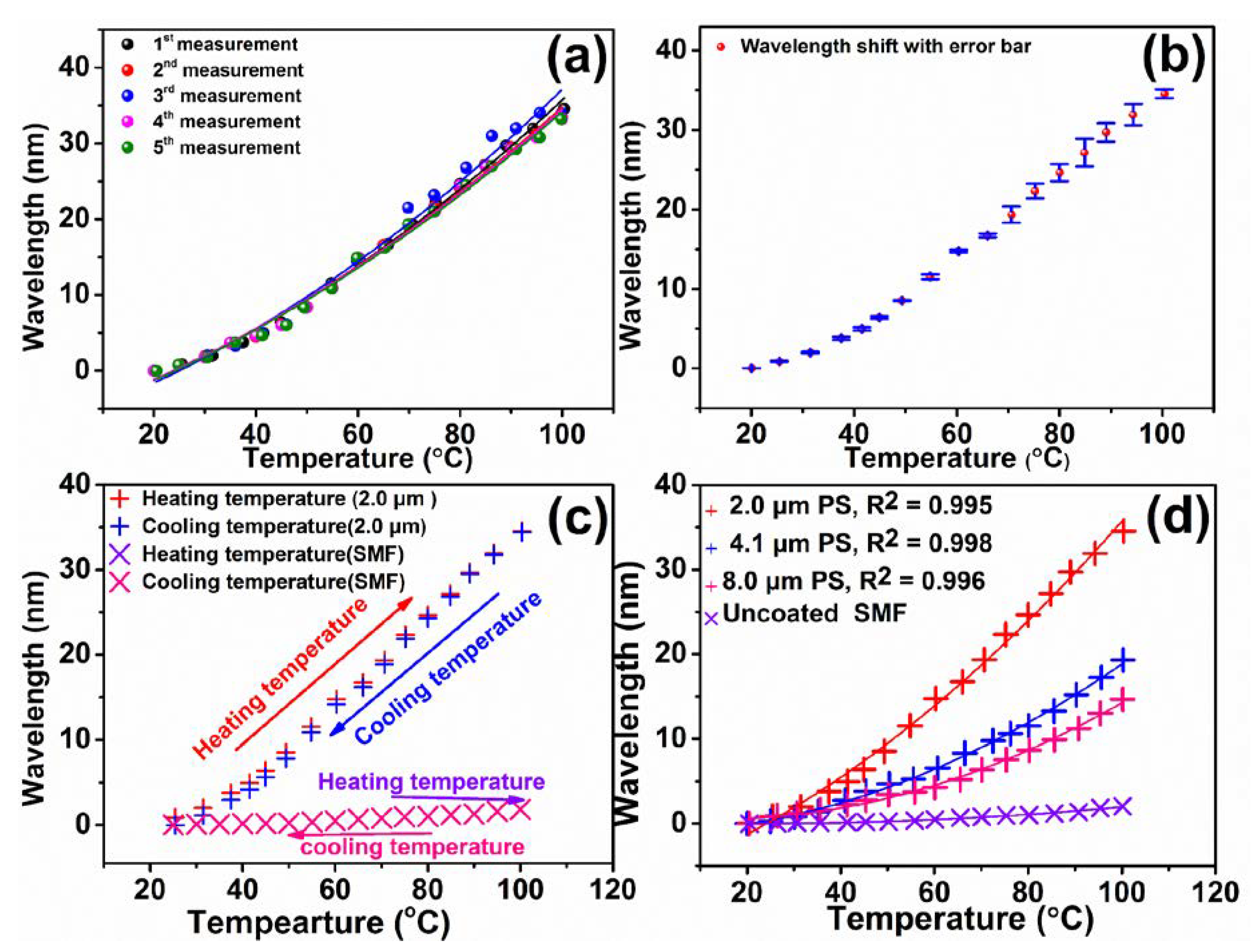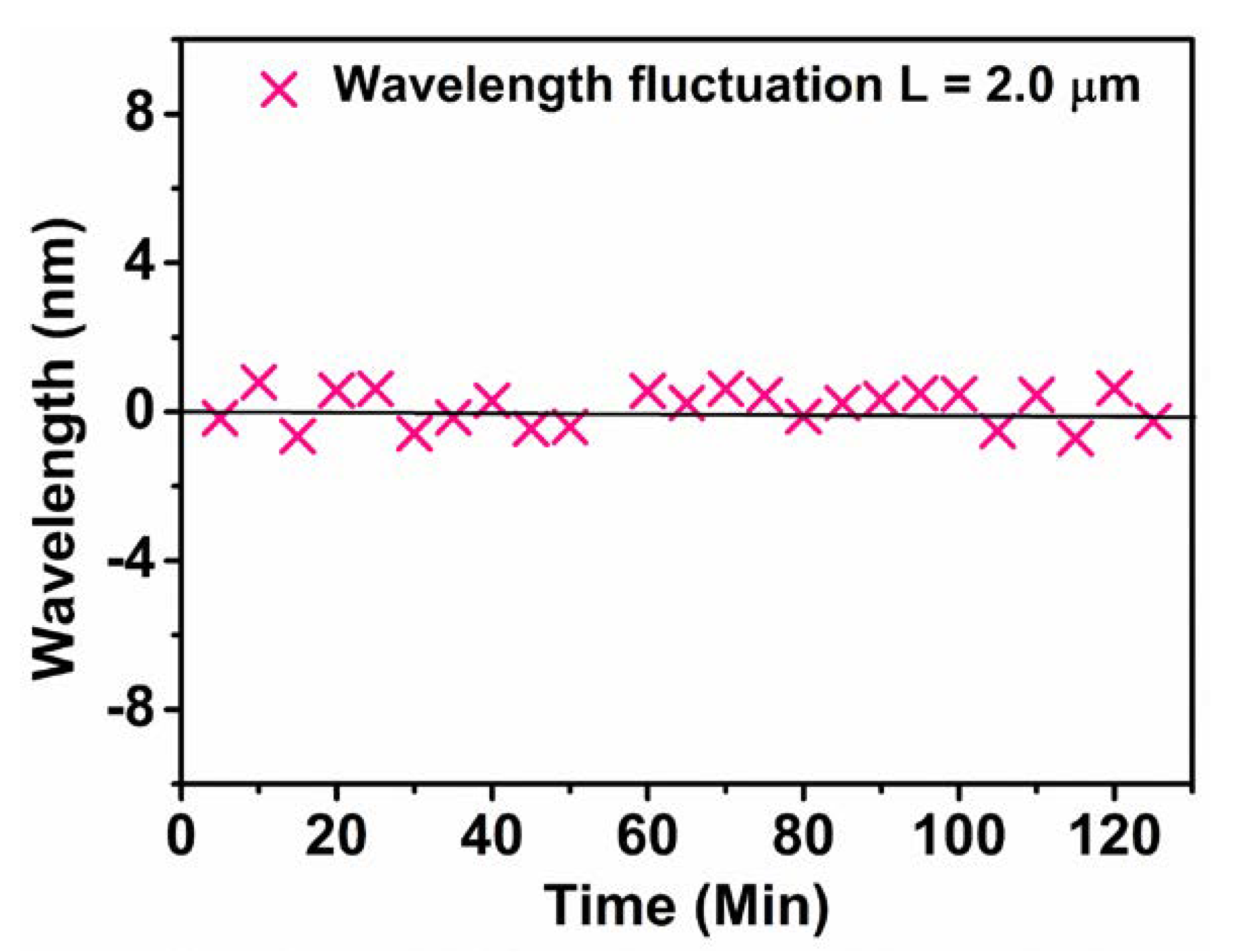Enhancing Temperature Sensitivity of the Fabry–Perot Interferometer Sensor with Optimization of the Coating Thickness of Polystyrene
Abstract
:1. Introduction
2. Sensing Principle
2.1. Fresnel Reflection Principle
2.2. Sensor Fabrication
2.3. Measurement Setup
2.4. Temperature Response Test
3. Results and Discussion
4. Conclusions
Supplementary Materials
Author Contributions
Funding
Conflicts of Interest
References
- Zaynetdinov, M.; See, E.M.; Geist, B.; Ciovati, G.; Robinson, H.D.; Kochergin, V. A Fiber Bragg Grating Temperature Sensor for 2–400 K. IEEE Sens. J. 2015, 15, 1908–1912. [Google Scholar] [CrossRef]
- Meng, H.; Shen, W.; Zhang, G.; Tan, C.; Huang, X. Fiber Bragg grating-based fiber sensor for simultaneous measurement of refractive index and temperature. Sens. Actuators B 2010, 150, 226–229. [Google Scholar] [CrossRef]
- Chen, J.; Huang, X. Fresnel-reflection-based fiber sensor for on-line measurement of ambient temperature. Opt. Commun. 2010, 283, 1674–1677. [Google Scholar] [CrossRef]
- Zhang, B.; Kahrizi, M. High-Temperature Resistance Fiber Bragg Grating Temperature Sensor Fabrication. IEEE Sens. J. 2007, 7, 586–591. [Google Scholar] [CrossRef]
- Liu, H.B.; Liu, H.Y.; Peng, G.D.; Chu, P.L. Strain and temperature sensor using a combination of polymer and silica fibre Bragg gratings. Opt. Commun. 2003, 219, 139–142. [Google Scholar] [CrossRef]
- Ismail, M.A.; Tamchek, N.; Hassan, M.R.A.; Dambul, K.D.; Selvaraj, J.; Rahim, N.A.; Sandoghchi, R.S.; Adikan, F.R.M. A Fiber Bragg Grating—Bimetal Temperature Sensor for Solar Panel Inverters. Sensors 2011, 11, 8665–8673. [Google Scholar] [CrossRef] [Green Version]
- Liu, H.; Liang, H.; Sun, M.; Ni, K.; Jin, Y. Simultaneous Measurement of Humidity and Temperature Based on a Long-Period Fiber Grating Inscribed in Fiber Loop Mirror. IEEE Sens. J. 2014, 14, 893–896. [Google Scholar] [CrossRef]
- Wang, Y.; Xiao, L.; Wang, D.N.; Jin, W. Highly sensitive long-period fiber-grating strain sensor with low temperature sensitivity. Opt. Lett. 2006, 31, 3414–3416. [Google Scholar] [CrossRef] [Green Version]
- Frazao, O.; Marques, L.M.; Santos, S.; Baptista, J.M.; Santos, J.L. Simultaneous Measurement for Strain and Temperature Based on a Long-Period Grating Combined with a High-Birefringence Fiber Loop Mirror. IEEE Photon. Technol. Lett. 2006, 18, 2407–2409. [Google Scholar] [CrossRef]
- Wang, Y.; Wang, D.N.; Liao, C.R.; Hu, T.; Guo, J.; Wei, H. Temperature-insensitive refractive index sensing by use of micro Fabry–Pérot cavity based on simplified hollow-core photonic crystal fiber. Opt. Lett. 2013, 38, 269–271. [Google Scholar] [CrossRef] [Green Version]
- Sun, H.; Luo, H.; Wu, X.; Liang, L.; Wang, Y.; Ma, X.; Zhang, J.; Hu, M.; Qiao, X. Spectrum ameliorative optical fiber temperature sensor based on hollow-core fiber and inner zinc oxide film. Sens. Actuators B 2017, 245, 423–427. [Google Scholar] [CrossRef]
- Nguyen, L.V.; Hwang, D.; Moon, S.; Moon, D.S.; Chung, Y. High temperature fiber sensor with high sensitivity based on core diameter mismatch. Opt. Express 2008, 16, 11369–11375. [Google Scholar] [CrossRef] [PubMed]
- Rajan, G.; Mathew, J.; Semenova, Y.; Farrell, G. Evaluation of the performance of a novel low-cost macro-bend fiber-based temperature sensor. Proc. SPIE Int. Soc. Opt. Eng. 2009, 7316, 731610. [Google Scholar]
- Guo, H.; Pang, F.; Zeng, X.; Chen, N.; Chen, Z.; Wang, T. Temperature sensor using an optical fiber coupler with a thin film. Appl. Opt. 2008, 47, 3530–3534. [Google Scholar] [CrossRef] [PubMed]
- Villalba, A.; Martín, J.C. Interferometric temperature sensor based on a water-filled suspended-core fiber. Opt. Fiber Technol. 2017, 33, 36–38. [Google Scholar] [CrossRef] [Green Version]
- Flores, R.; Janeiro, R.; Viegas, J. Optical fibre Fabry-Pérot interferometer based on inline microcavities for salinity and temperature sensing. Sci. Rep. 2019, 9, 9556–9565. [Google Scholar] [CrossRef]
- Chowdhury, S.A.; Correia, R.; Francis, D.; Brooks, S.J.; Jones, B.J.S.; Thompson, A.W.J.; Hodgkinson, J.; Tatam, R.P. An Optical Fiber Hydrogen Sensor Using a Palladium-Coated Ball Lens. J. Lightwave Technol. 2015, 33, 2535–2542. [Google Scholar] [CrossRef] [Green Version]
- Bariain, C.; Matias, I.R.; Arregui, F.J.; Lopez-Amo, M. Optical fiber humidity sensor based on a tapered fiber coated with agarose gel. Sens. Actuators B 2000, 69, 127–131. [Google Scholar] [CrossRef]
- Mathew, J.; Semenova, Y.; Farrell, G. Relative Humidity Sensor Based on an Agarose-Infiltrated Photonic Crystal Fiber Interferometer. IEEE J. Sel. Top. Quant. Electron. 2012, 18, 1553–1559. [Google Scholar] [CrossRef]
- Arregui, F.J.; Matias, I.R.; Cooper, K.L.; Claus, R.O. Simultaneous measurement of humidity and temperature by combining a reflective intensity-based optical fiber sensor and a fiber Bragg grating. IEEE Sens. J. 2002, 2, 482–487. [Google Scholar] [CrossRef]
- Rong, Q.; Sun, H.; Qiao, X.; Zhang, J.; Hu, M.; Feng, Z. A miniature fiber—Optic temperature sensor based on a Fabry–Perot interferometer. J. Opt. 2012, 14, 045002. [Google Scholar] [CrossRef]
- Sampath, U.; Kim, D.; Kim, H.; Song, M. Cryogenic Temperature Sensor Based on Fresnel Reflection from a Polymer-Coated Facet of Optical Fiber. IEEE Sens. J. 2018, 18, 3640–3644. [Google Scholar] [CrossRef]
- Romano, I.H.; Hernández, D.M.; Hernández, C.M.; Hernandez, D.M.; Villatoro, J. Highly Sensitive Temperature Sensor Based on a Polymer-Coated Microfiber Interferometer. IEEE Photon. Technol. Lett. 2015, 27, 2591–2594. [Google Scholar] [CrossRef]
- Estella, J.; Vicente, P.D.; Echeverria, J.C.; Garrido, J.J. A fibre-optic humidity sensor based on a porous silica xerogel film as the sensing element. Sens. Actuators B 2010, 149, 122–128. [Google Scholar] [CrossRef]
- Zhang, Y.; Wang, F.; Liu, Z.; Duan, Z.; Cui, W.; Han, J.; Gu, Y.; Wu, Z.; Jing, Z.; Sun, C.; et al. Fiber-optic anemometer based on single-walled carbon nanotube coated tilted fiber Bragg grating. Opt. Express 2017, 25, 24521–24530. [Google Scholar] [CrossRef]
- Wong, W.C.; Chan, C.C.; Chen, L.H.; Li, T.; Lee, K.X.; Leong, K.C. Polyvinyl alcohol coated photonic crystal optical fiber sensor for humidity measurement. Sens. Actuators B 2012, 174, 563–569. [Google Scholar] [CrossRef]
- Muto, S.; Suzuki, O.; Amano, T.; Morisawa, M. A plastic optical fibre sensor for real-time humidity monitoring. Meas. Sci. Technol. 2003, 14, 746–750. [Google Scholar] [CrossRef]
- Salunkhe, T.T.; Lee, H.K.; Choi, H.W.; Park, S.J.; Kim, J.H.; Kim, I.T. High sensitivity temperature sensor based on Fresnel reflection with thermosensitive polymer: control of morphology and coating thickness. Jpn. J. Appl. Phys. 2019. Article on press. [Google Scholar] [CrossRef]
- El-Amassi, D.M.; Taya1, S.A.; Vigneswaran, D. Temperature sensor utilizing a ternary photonic crystal with a polymer layer sandwiched between Si and SiO2 layers. J. Theor. Appl. Phys. 2018, 12, 293–298. [Google Scholar] [CrossRef]
- Esposito, F.; Zotti, A.; Palumbo, G.; Zuppolini, S.; Consales, M.; Cutolo, A.; Borriello, A.; Campopiano, S.; Zarrelli, M.; Iadicicco, A. Liquefied Petroleum Gas Monitoring System Based on Polystyrene Coated Long Period Grating. Sensors 2018, 18, 1435. [Google Scholar] [CrossRef] [Green Version]
- Zhang, Z.; Zhao, P.; Lin, P.; Sun, F. Thermo-optic coefficients of polymers for optical waveguide applications. Polymer 2006, 47, 4893–4896. [Google Scholar] [CrossRef]
- Van Krevelen, D.W.; Nijenhuis, K.T. Properties of Polymer; Elsevier Science: Oxford, UK, 2009. [Google Scholar]
- Lee, C.L.; You, Y.W.; Dai, J.H.; Hsu, J.M.; Horng, J.S. Hygroscopic polymer microcavity fiber Fizeau interferometer incorporating a fiber Bragg grating for simultaneously sensing humidity and temperature. Sens. Actuators B 2016, 222, 339–346. [Google Scholar] [CrossRef]
- Bass, M. Optical Society of America. Handbook of Optics: Fundamentals, Techniques, and Design; McGraw-Hill: New York, NY, USA, 2010. [Google Scholar]
- Zhao, J.; Huang, X.; He, W.; Chen, J. High-Resolution and Temperature-Insensitive Fiber Optic Refractive Index Sensor Based on Fresnel Reflection Modulated by Fabry–Perot Interference. J. Lightwave Technol. 2010, 28, 2799–2803. [Google Scholar] [CrossRef]
- Tsuda, H.; Urabe, K. Characterization of Long-period Grating Refractive Index Sensors and Their Applications. Sensors 2009, 9, 4559–4571. [Google Scholar] [CrossRef] [PubMed]
- Maheshwaryl, S.; Mehra, R. Fiber Bragg grating based fiber sensor for simultaneous measurement of the refractive index and temperature. In Proceedings of the 2016 IEEE 1st International Conference on Power Electronics, Intelligent Control and Energy Systems (ICPEICES), Delhi, India, 4–6 July 2016. [Google Scholar]
- Watanabe, D.; Fukano, H.; Taue, S. High Sensitivity Optical-fiber Temperature Sensor with Solid Cladding Material Based on Multimode Interference. In Proceedings of the 2015 Opto-Electronics and Communications Conference (OECC), Shanghai, China, 28 June–2 July 2015. [Google Scholar]
- Zheng, L.; Vaillancourt, J.; Armiento, C.; Lu, X. Thermo-optically tunable fiber ring laser without any mechanical moving parts. Opt. Eng. 2006, 45, 070503. [Google Scholar] [CrossRef] [Green Version]
- Sun, B.; Wang, Y.; Qu, J.; Liao, C.; Yin, G.; He, J.; Zhou, J.; Tang, J.; Liu, S.; Li, Z.; et al. Simultaneous measurement of pressure and temperature by employing Fabry-Perot interferometer based on pendant polymer droplet. Opt. Express 2015, 23, 1906. [Google Scholar] [CrossRef] [Green Version]
- Pilla, V.; Catunda, T.; Balogh, D.T.; Faria, R.M.; Zilio, S.C. Thermal lensing in poly (vinyl alcohol)/polyaniline blends, Poly (vinyl alcohol)/Polyaniline. Blends 2002, 40, 1949–1956. [Google Scholar]
- Zhang, Z.; Liao, C.; Tang, J.; Bai, Z.; Guo, K.; Hou, M.; He, J.; Wang, Y.; Liu, S.; Zhang, F.; et al. High-Sensitivity Gas-Pressure Sensor Based on Fiber-Tip PVC Diaphragm Fabry–Perot Interferometer. J. Lightwave Technol. 2017, 35, 4067–4071. [Google Scholar] [CrossRef]
- Chen, M.; Zhao, Y.; Xia, F.; Peng, Y.; Tong, R. High sensitivity temperature sensor based on fiber air-microbubble Fabry-Perot interferometer with PDMS-filled hollow-core fiber. Sens. Actuators A 2018, 275, 60–66. [Google Scholar] [CrossRef]
- Gea, M.; Lia, Y.; Hana, Y.; Xiaa, Z.; Guob, Z.; Gaoc, J.; Qu, S. High-sensitivity double-parameter sensor based on the fibre-tip Fabry–Pérot interferometer. J. Mod. Opt. 2016, 64, 596–600. [Google Scholar] [CrossRef]
- Wu, C.; Fu, H.Y.; Qureshi, K.K.; Guan, B.O.; Tam, H.Y. High-pressure and high-temperature characteristics of a Fabry–Perot interferometer based on photonic crystal fiber. Opt. Lett. 2011, 36, 412–414. [Google Scholar] [CrossRef] [PubMed] [Green Version]
- Liu, G.; Sheng, Q.; Hou, W.; Han, M. High-resolution, large dynamic range fiber-optic thermometer with cascaded Fabry–Perot cavities. Opt. Lett. 2016, 41, 5134–5137. [Google Scholar] [CrossRef] [PubMed]
- Liu, G.; Han, M.; Hou, W. High-resolution and fast-response fiber-optic temperature sensor using silicon Fabry-Pérot cavity. Opt. Express 2015, 23, 7237–7247. [Google Scholar] [CrossRef] [PubMed] [Green Version]







| Polymer | Refractive Index | TOC (°C−1) | CTE (°C−1) | Operational Temp (°C) | Ref. |
|---|---|---|---|---|---|
| Epoxy | 1.438 | −1.0 × 10−4 | 1.7 × 10−4 | 25–100 | [38] |
| PMMA | 1.48 | −1.3 × 10−4 | 2.2 × 10−4 | 90 | [31] |
| PC | 1.585 | −0.9 × 10−4 | 1.7 × 10−4 | 25–140 | [31] |
| NOA 61 | 1.56 (1.541 before UV treatment) | −1.17 × 10−4 | 2.2 × 10−4 | 20–50 | [33,39] |
| NOA 65 | 1.524 (1.515 before UV treatment) | −1.18 × 10−4 | - | 20–90 | [40] |
| PVC | 1.53 (1.546) | −1.14 × 10−4 | 2 × 10−4 | 20–60 | [41,42] |
| PS | 1.59 | −1.2 × 10−4 | 2.2 × 10−4 | 20–100 | This work |
| Sensor (PS Thickness) | Sensitivity (pm/°C) | Standard Deviation in Sensitivity (pm/°C) |
|---|---|---|
| 2.0 μm | 439.89 | 0.048 |
| 4.1 μm | 219.39 | 0.042 |
| 8.0 μm | 147.52 | 0.03 |
| Types of Fiber | Polymer | T (°C) | Sensitivity (pm °C−1) | Ref. |
|---|---|---|---|---|
| Fabry–Perot Interferometer | PVA | 25–100 | ~193.3 | [21] |
| Fiber Bragg grating | NOA-61 | 10–50 | 19.5 | [33] |
| Fiber Fizeau interferometer | NOA-61 | 10–50 | 269.5 | [33] |
| Fabry–Perot Interferometer | PVC | 25–60 | 366.0 | [42] |
| Single mode + Hollow core fiber | HCF-PDMS | 51–70.5 | 2703.5 | [43] |
| Microfiber mode interferometer | PDMS | 20–48 | 3101.7 | [23] |
| Fabry–Perot Interferometer | Dual polymer capped PDMS | 20–75 | 689.68 | [44] |
| Fabry–Perot Interferometer | PC | 20–140 | 245.4 | [28] |
| Fabry–Perot Interferometer | PS | 80–10025–100 | 510.28 439.89 | This work |
© 2020 by the authors. Licensee MDPI, Basel, Switzerland. This article is an open access article distributed under the terms and conditions of the Creative Commons Attribution (CC BY) license (http://creativecommons.org/licenses/by/4.0/).
Share and Cite
Salunkhe, T.T.; Lee, D.J.; Lee, H.K.; Choi, H.W.; Park, S.J.; Kim, I.T. Enhancing Temperature Sensitivity of the Fabry–Perot Interferometer Sensor with Optimization of the Coating Thickness of Polystyrene. Sensors 2020, 20, 794. https://doi.org/10.3390/s20030794
Salunkhe TT, Lee DJ, Lee HK, Choi HW, Park SJ, Kim IT. Enhancing Temperature Sensitivity of the Fabry–Perot Interferometer Sensor with Optimization of the Coating Thickness of Polystyrene. Sensors. 2020; 20(3):794. https://doi.org/10.3390/s20030794
Chicago/Turabian StyleSalunkhe, Tejaswi Tanaji, Dong Jun Lee, Ho Kyung Lee, Hyung Wook Choi, Sang Joon Park, and Il Tae Kim. 2020. "Enhancing Temperature Sensitivity of the Fabry–Perot Interferometer Sensor with Optimization of the Coating Thickness of Polystyrene" Sensors 20, no. 3: 794. https://doi.org/10.3390/s20030794





